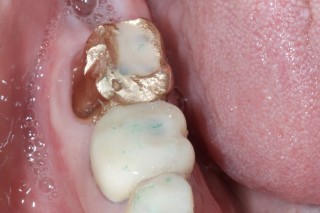 This is a patient who after several years of procrastinating has decided to move forward with treatment. The deciding factor for her was recurrent decay under the anterior bridge, leaving both abutments non-restorable and with decay so severe that even the roots could not be used to extrude and build boney bed for implants.
This is a patient who after several years of procrastinating has decided to move forward with treatment. The deciding factor for her was recurrent decay under the anterior bridge, leaving both abutments non-restorable and with decay so severe that even the roots could not be used to extrude and build boney bed for implants.The other issue is the occlusal plane, most noticeably in the lower arch. She knows she grinds her teeth and she has been evaluated for sleep disorders. She is wearing a CPAP with success, and she thinks she is grinding much less as long as she uses the machine.
So, how do we change the lower arch and make restorative room? When there is this much wear, it is not uncommon for overjet and overbite to diminish, as is the case here. That means that if we would like the orthodontist to intrude these teeth, there is no place to put brackets and not have them get knocked off by the upper teeth.

Another issue is the number of teeth that need to be intruded—all of the lower incisors, the left canine and premolars and even the first molar. How do we move all of those teeth without orthognathic surgery?
With TADs (Temporary Anchorage Devices), the orthodontist can move segments of teeth at the same time instead of having to do it incrementally one or two teeth at a time. These small implants are surgical screws that are placed below the level of the roots of teeth being moved and allow the orthodontist to pull against the screws and intrude the teeth.
The question then remains, how does the orthodontist place brackets? The solution is by simply bonding composite onto the occlusal surfaces of the lower posterior teeth to open the bite in the anterior. This allows for room for brackets to be placed without fear of them interfering with the anterior teeth. In this case about 1-1.5mm of composite was added to the second molars to open the bite about 4mm in the anterior.
 In order to make the bite more comfortable for the patient, composite was add to the first molars and second premolars as well so she has even contacts bilaterally in the posterior. At least until teeth start moving.
In order to make the bite more comfortable for the patient, composite was add to the first molars and second premolars as well so she has even contacts bilaterally in the posterior. At least until teeth start moving.The process takes about 45 minutes to complete and the composite is adjusted to a single contact on each posterior tooth.
Implants make life easier is many clinical situations and this case is a great example.
 
Steve Ratcliff, D.D.S., M.S., Spear Faculty and Contributing Author

Want to dive even deeper into clinical topics like this? Check out our clinical categories in our Course Library. Not yet a member of Spear Online? Click here to learn more.